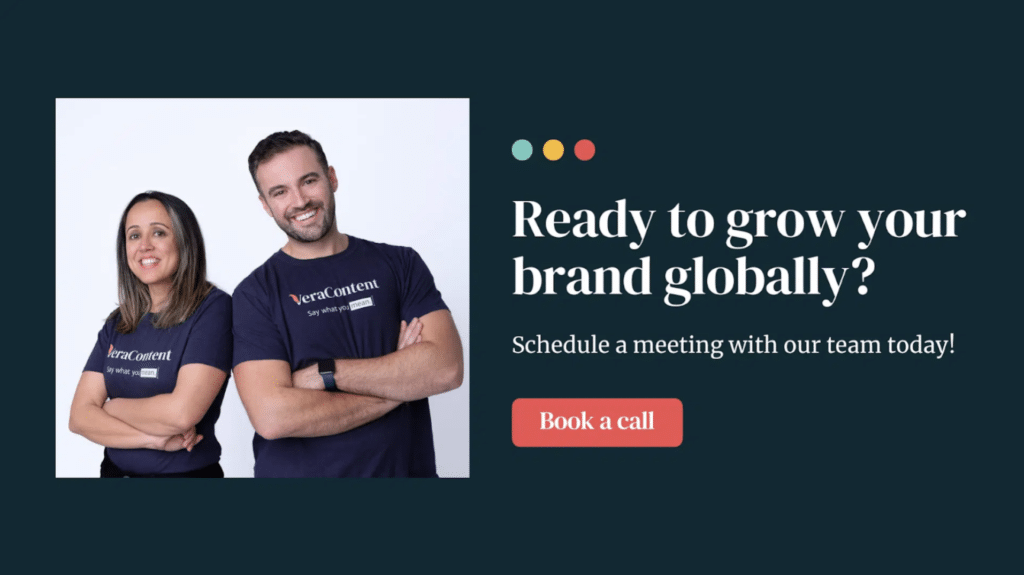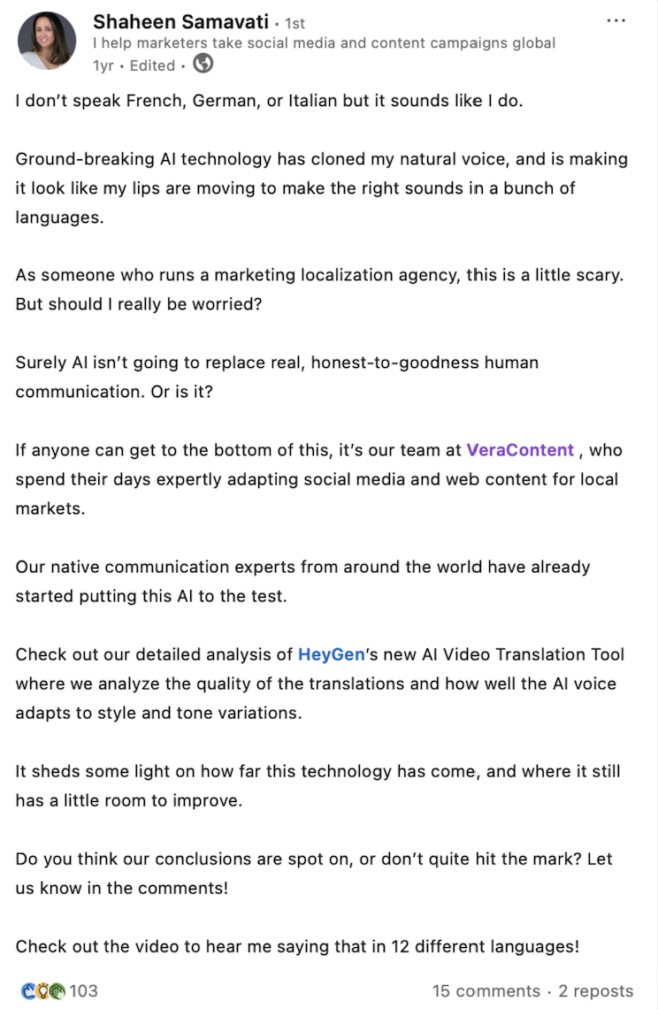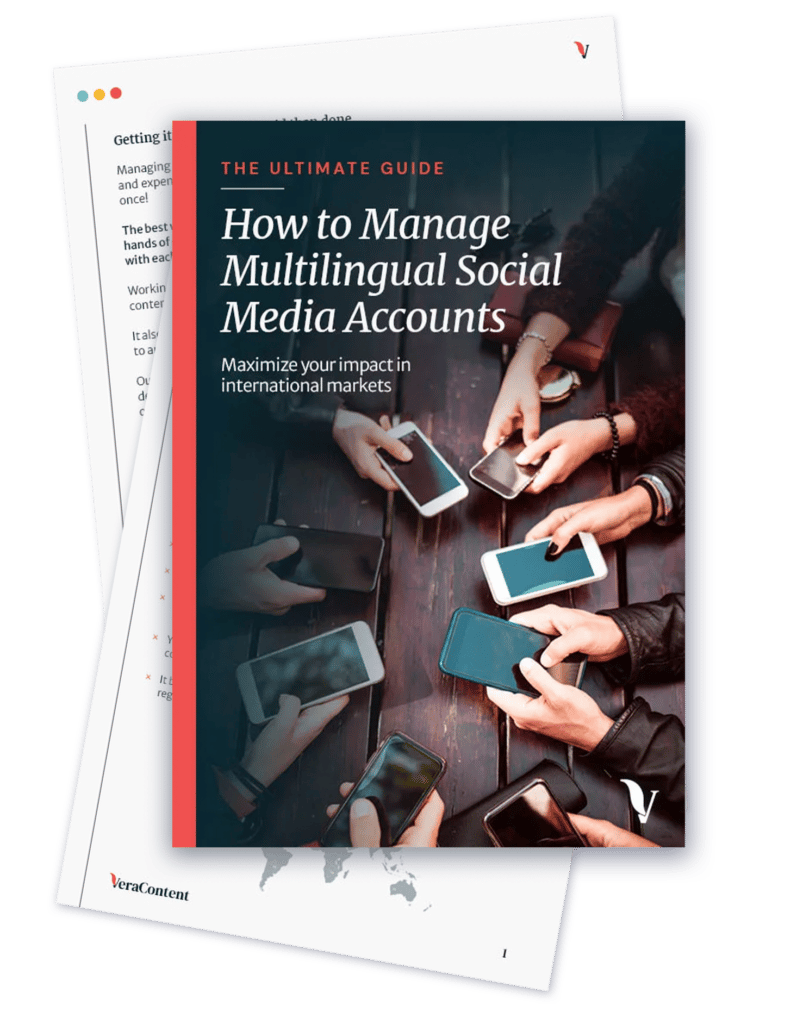Scaling LinkedIn content for global audiences is tough—balancing cultural nuances, consistency and engagement across markets takes time. But AI is making it a whole lot easier.
By automating localization, streamlining workflows and delivering data-driven insights, AI helps global marketers focus on strategy while maintaining authenticity—the key to building B2B trust.
Keep reading for practical advice on creating your own AI-powered LinkedIn strategy. We’ll show you how to optimize your LinkedIn content without losing the human touch.
Here’s our recap:
Why you should invest in an AI-powered LinkedIn content strategy

LinkedIn remains the top platform for B2B marketing, connecting brands with decision-makers and professionals worldwide. However, when scaling global campaigns, marketers can’t simply share the same content in every market. Cultural preferences, language differences and varying engagement behaviors require a specific approach.
Investing in an AI-powered LinkedIn content strategy can help you with tasks like:
- Content creation
- Localization
- Audience analysis
Yet, the real value comes from combining AI’s efficiency with human creativity and strategic direction. By using AI to optimize content for different markets, marketers can ensure their messaging stays authentic, builds trust, and engages audiences without compromising the human touch.
“As soon as ChatGPT came onto the scene, it felt like a leap forward,” says Shaheen Samavati, CEO of VeraContent. “We knew we had to figure out how to use it responsibly because it was clear this was going to change things in our industry.”
AI-powered tools like ChatGPT and Jasper can streamline content ideation, drafting and refinement, enabling marketing teams to maintain consistency while tailoring content for each market. By leveraging AI to optimize messaging without losing authenticity, brands can build trust and engage audiences on a global scale.
See also: Generating quality global content at scale using AI tools
Using AI to localize LinkedIn content for global audiences

Reaching a global audience on LinkedIn requires more than just translating content. AI-powered tools help marketers adapt messaging for the different targeted markets.
Here’s how AI can support localization:
- AI-assisted translation (with human oversight)
AI tools like DeepL and Google Translate speed up translation, but context and tone can still be a challenge. Using AI for the initial draft and refining it with native speakers will help ensure the messaging is culturally relevant.
See also: AI translation: Helpful tool or just plagiarism in disguise?
- Adapting tone and messaging
AI can analyze audience opinion and engagement across regions, helping to adjust tone and style for each market. For instance, a more formal tone is needed in Germany, while Latin American audiences engage better with a community-driven approach.
See also: AI content analysis: Tools to measure marketing performance
- Optimizing content formats for local preferences
AI analytics can track regional engagement trends to help marketers choose the best format, whether it’s long-form articles, carousel posts or videos—all based on local preferences.
- Automating scheduling across time zones
AI tools can also help determine the optimal times to post, ensuring content reaches the right audience at the right moment, regardless of time zone.

Balancing AI and human storytelling on LinkedIn

AI-generated content can be efficient, but relying too much on automation can make posts feel impersonal, and get less engagement than expected. In B2B marketing, where trust and credibility are essential, the human touch is what makes content relatable and engaging.
Here’s how to strike the right balance between AI efficiency and authentic storytelling on LinkedIn:
1. Use AI for efficiency, but stay in control
AI can generate post drafts, suggest topics and refine messaging, but human oversight is what makes content feel authentic and aligned with your brand voice. Think of AI as an assistant—it can streamline the process, but humans should always have the final say.
As Naomi Bleackley, VeraContent Editorial, AI and Process Manager, shared:
“AI isn’t perfect at all. It’s a great tool, but it’s not going to replace humans because it doesn’t think like a human. The answers it produces may look fluent, but that doesn’t mean they’re accurate or nuanced.”
This is why marketers should use AI to handle repetitive tasks while ensuring the final content reflects human expertise, emotional intelligence and strategic intent. AI can assist, but it’s human creativity and critical thinking that make content truly resonate.
2. Infuse posts with personal insights
AI can structure posts, but it definitely can’t replicate personal experiences, industry knowledge or real-life case studies. It’s crucial to add your own insights, anecdotes or lessons learned, in order to make your posts more engaging and relatable.
Don’t let AI make its own judgment; specify the source material you want it to use. Maybe it’s a client case study or a presentation a colleague recently gave about a conference they attended.
See also: Top 5 LinkedIn content trends for global marketers in 2025
3. Always maintain a conversational tone
AI-generated content can frequently sound robotic or overly polished. To make your posts more engaging, adjust the tone to feel conversational and natural. Adding rhetorical questions, humor or informal phrases will humanize your content.
4. Use AI for data-driven storytelling
AI tools can identify trending topics and audience preferences, turning data into relevant stories. Instead of simply sharing data points, create narratives that connect with your audience.
For example, instead of “80% of B2B marketers struggle with content consistency,” try: “Keeping LinkedIn content consistent can feel like a full-time job. 80% of B2B marketers feel the same way.” This sounds more human and invites conversation.
As Naomi Bleakley shared:
“The key to using AI effectively is in the prompts. The better and clearer the instructions, the better the output. It’s a new kind of creativity that’s all about being specific and intentional.”
5. Humanize AI-generated visuals and captions
AI can assist with visuals and captions, but they should still reflect a human perspective. Adding a personal comment or insight to an infographic or refining AI-generated captions will make your content feel more authentic and engaging.
The key to success on LinkedIn is not choosing between AI and human creativity, it’s knowing when and how to use each. AI streamlines content creation, while human storytelling adds the authentic touch that keeps driving trust and engagement.
For more insights on practical applications of AI, such as content repurposing, custom GPTs and responsible use, check out our latest podcast episode: Practical ways to use AI in content marketing.
Enhancing LinkedIn engagement with AI insights
As mentioned before, AI doesn’t just help with content creation, it also provides insights that can improve engagement and help global marketers make more data-driven decisions. It allows brands to refine their LinkedIn strategies for maximum impact by analyzing audience behavior, optimizing post timing and identifying high-performing content.
Here’s how to make AI insights work for your LinkedIn strategy:
1. Identify trending topics and audience interests
AI tools can scan vast amounts of data to detect growing trends and identify what your target audience cares about. Platforms like LinkedIn’s content suggestions or third-party analytics can surface trending hashtags, keywords and topics relevant to your industry.
How to apply it:
- Use AI tools to monitor hashtags and keywords trending within your niche.
- Track competitor content to identify the type of posts that are driving the most engagement.
- Create posts around emerging topics to stay relevant and timely.
A great example of this balance in action is how Shaheen Samavati, our CEO at VeraContent, used AI to create an engaging LinkedIn post.

She tested HeyGen’s new AI video translation tool, which cloned her voice and lip movements to make it look like she was speaking multiple languages. The video, which you can watch below, sparked a discussion on the potential of AI in content localization and whether it can ever truly replace human communication.
By sharing her own experience and insights, Shaheen used AI not just as a tool, but as a conversation starter—demonstrating the kind of authentic engagement that makes LinkedIn content stand out.
Related content: Global social media marketing trends to watch in 2025
2. Optimize post timing across time zones
AI-powered scheduling tools can identify when your audience is most likely to engage. By analyzing past engagement data, these tools can recommend optimal posting times based on your audience’s activity patterns.
How to apply it:
- Use AI-powered tools like Buffer or Hootsuite to find your audience’s peak engagement windows.
- Experiment with scheduling posts at different times for specific regions and analyze the results.
- Continuously adjust based on real-time performance data from AI-driven platforms.
3. Use AI analytics to track and improve performance
AI-driven analytics provide real-time insights into how your LinkedIn content is performing. These tools can help identify what’s working, suggest changes and predict future trends based on past data.
How to apply it:
- Monitor key metrics like shares, comments and click-through rates and ask AI to study these patterns.
- Analyze high-performing posts to detect common patterns and replicate them in future campaigns.
- Regularly refine your strategy using AI-driven recommendations.
See also: Global social media reporting: Essential KPIs you should be tracking
AI as a strategic advantage for global LinkedIn marketing
AI is reshaping how global B2B marketers approach LinkedIn, making it easier to scale content, localize messaging and engage diverse audiences. By utilizing AI for content ideation, automation and analytics, brands can simplify their efforts without sacrificing the authenticity that builds trust in B2B relationships.
However, the real strength of AI lies in how it complements human creativity. While AI can enhance efficiency, it should never replace the human touch. The best LinkedIn content strategies strike a balance, using AI to handle repetitive tasks while keeping storytelling and engagement deeply human.
As Naomi Bleakley shared in our latest episode of The Global Marketer, “AI isn’t replacing jobs; it’s enhancing them. It helps us maintain consistency, follow client-specific rules, and handle repetitive tasks, so we can focus on the more creative aspects of our work.”
To help streamline your own LinkedIn content creation, here are some AI tools we recommend:
- ChatGPT: Perfect for content ideation, drafting, and refining posts.
- Writer.com: A versatile tool for creating high-quality, personalized content.
- Jasper: Known for generating engaging copy and blog posts.
- Copy.ai: Great for creating attention-grabbing headlines and ad copy.
- Grammarly: Helps polish content by checking grammar, tone, and clarity.
- DeepL: For accurate, nuanced translations, ensuring localization stays on point.
- Custom GPTs (via OpenAI): Tailor AI to suit your specific content needs and brand voice.
- Google Translate: Ideal for basic translations, especially for multilingual content.
AI is here to stay, and brands that embrace this technology strategically will gain a strategic advantage. However, the key to success lies in using AI strategically—enhancing efficiency without losing the human touch that makes content resonate.
Want to dive deeper into AI-powered LinkedIn content strategy? Book a call with our team to explore how AI can optimize your strategy.


